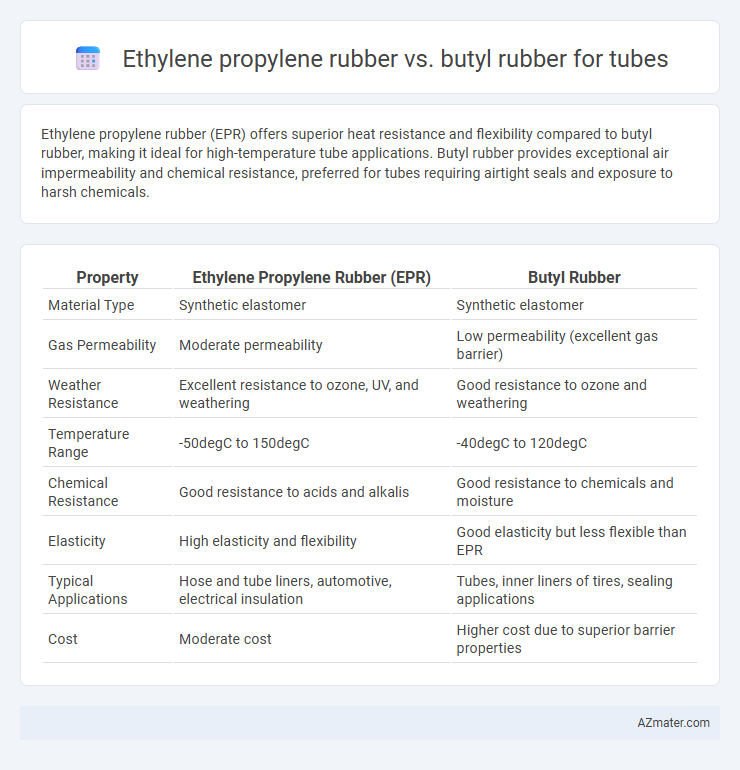Ethylene propylene rubber (EPR) offers superior heat resistance and flexibility compared to butyl rubber, making it ideal for high-temperature tube applications. Butyl rubber provides exceptional air impermeability and chemical resistance, preferred for tubes requiring airtight seals and exposure to harsh chemicals.
Table of Comparison
| Property | Ethylene Propylene Rubber (EPR) | Butyl Rubber |
|---|---|---|
| Material Type | Synthetic elastomer | Synthetic elastomer |
| Gas Permeability | Moderate permeability | Low permeability (excellent gas barrier) |
| Weather Resistance | Excellent resistance to ozone, UV, and weathering | Good resistance to ozone and weathering |
| Temperature Range | -50degC to 150degC | -40degC to 120degC |
| Chemical Resistance | Good resistance to acids and alkalis | Good resistance to chemicals and moisture |
| Elasticity | High elasticity and flexibility | Good elasticity but less flexible than EPR |
| Typical Applications | Hose and tube liners, automotive, electrical insulation | Tubes, inner liners of tires, sealing applications |
| Cost | Moderate cost | Higher cost due to superior barrier properties |
Introduction to Rubber Tubes
Ethylene propylene rubber (EPR) offers excellent resistance to heat, ozone, and weathering for rubber tubes used in automotive and industrial applications. Butyl rubber provides superior impermeability and chemical resistance, making it ideal for tubes that require airtight seals and protection against gases. Both materials deliver flexibility and durability, with EPR excelling in thermal stability and Butyl rubber in gas retention and chemical resistance for optimal tube performance.
Overview of Ethylene Propylene Rubber (EPR/EPDM)
Ethylene Propylene Rubber (EPR/EPDM) is a synthetic elastomer known for its excellent resistance to heat, oxidation, UV radiation, and weathering, making it ideal for tube applications exposed to harsh environmental conditions. Its saturated polymer backbone ensures superior chemical stability and flexibility over a wide temperature range, typically from -50degC to 150degC. EPR tubes offer enhanced durability and insulating properties compared to Butyl rubber, which is more limited in temperature resistance and chemical exposure.
Overview of Butyl Rubber (IIR)
Butyl rubber (IIR) is a synthetic elastomer known for its excellent impermeability to gases, superior resistance to heat, chemical inertness, and outstanding vibration dampening properties, making it ideal for tube applications requiring airtight performance. Compared to ethylene propylene rubber (EPR), butyl rubber offers enhanced resistance to ozone, weathering, and aging, while maintaining flexibility at low temperatures. Its low permeability and high resilience contribute to longer service life and reliability in harsh environments, especially in automotive and industrial tubing.
Key Physical Properties Comparison
Ethylene propylene rubber (EPR) offers superior resistance to heat, ozone, and weathering, making it ideal for outdoor tube applications requiring flexibility and durability. Butyl rubber excels in impermeability and chemical resistance, providing excellent air retention and resistance to moisture and gases in tube manufacturing. EPR typically displays higher tensile strength and elongation at break, while butyl rubber is known for its low permeability and excellent damping properties.
Air Retention and Permeability
Ethylene propylene rubber (EPR) offers moderate air retention with higher permeability compared to butyl rubber, which is renowned for its superior air impermeability and exceptional air retention properties. Butyl rubber's dense molecular structure significantly reduces gas permeability, making it the preferred material for tubes requiring long-term air retention, such as inner tubes and inflatable seals. EPR is more suitable for applications where flexibility and resistance to heat and weathering are prioritized over maximum air tightness.
Resistance to Weathering and Ozone
Ethylene propylene rubber (EPR) offers superior resistance to weathering and ozone due to its saturated polymer backbone, which prevents degradation under UV exposure and oxidative environments. Butyl rubber, while highly impermeable and flexible, shows moderate resistance to ozone but can degrade faster when exposed to prolonged weathering and UV radiation. EPR is preferred for tubes used in harsh outdoor conditions where long-term ozone and weather resistance are critical.
Temperature and Heat Resistance
Ethylene propylene rubber (EPR) exhibits excellent heat resistance, maintaining flexibility and performance in temperatures ranging from -50degC to 150degC, making it ideal for high-temperature tube applications. Butyl rubber, although having superior impermeability and chemical resistance, generally withstands temperatures only between -40degC and 120degC, limiting its use in extreme heat conditions. EPR's stable thermal properties enhance tube durability in automotive and industrial environments exposed to prolonged heat.
Chemical Compatibility for Tubes
Ethylene propylene rubber (EPR) demonstrates superior chemical resistance to acids, alkalis, and polar solvents, making it ideal for tubes exposed to a wide range of aggressive chemicals. Butyl rubber offers excellent impermeability and resistance to gases, chemicals, and weathering, particularly excelling in applications involving ketones, esters, and polar solvents. When selecting tube materials, EPR is preferred for environments requiring resistance to oxidative and ozone degradation, while butyl rubber is favored for applications demanding superior gas retention and resistance to polar compounds.
Typical Applications in Tubing
Ethylene propylene rubber (EPR) is widely used in tubing for its excellent resistance to heat, ozone, and weathering, making it ideal for automotive fuel lines, industrial hoses, and water tubing applications. Butyl rubber stands out in tubing where airtightness and chemical resistance are critical, commonly applied in pharmaceutical tubing, medical devices, and inner tubes for tires. Both materials offer durability, but EPR excels in thermal stability while butyl rubber delivers superior impermeability to gases.
Choosing the Right Rubber for Tube Applications
Ethylene propylene rubber (EPR) and butyl rubber are both excellent choices for tube applications, with selection largely dependent on operating conditions and performance requirements. EPR offers superior heat, ozone, and weather resistance, making it ideal for automotive and industrial tubing exposed to harsh environments. Butyl rubber excels in air and gas impermeability, providing exceptional sealing and cushioning properties for applications such as medical tubing and airtight seals.

Infographic: Ethylene propylene rubber vs Butyl rubber for Tube
 azmater.com
azmater.com